水稻育种相关专业词汇与术语 整理版
- 格式:pdf
- 大小:644.29 KB
- 文档页数:72
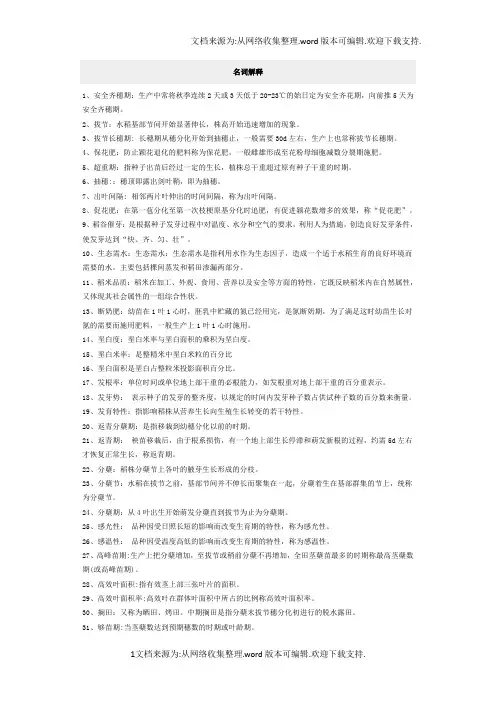
名词解释1、安全齐穗期:生产中常将秋季连续2天或3天低于20-23℃的始日定为安全齐花期,向前推5天为安全齐穗期。
2、拔节:水稻基部节间开始显著伸长,株高开始迅速增加的现象。
3、拔节长穗期: 长穗期从穗分化开始到抽穗止,一般需要30d左右,生产上也常称拔节长穗期。
4、保花肥:防止颖花退化的肥料称为保花肥,一般雌雄形成至花粉母细胞减数分裂期施肥。
5、超重期:指种子出苗后经过一定的生长,植株总干重超过原有种子干重的时期。
6、抽穗::穗顶即露出剑叶鞘,即为抽穗。
7、出叶间隔: 相邻两片叶伸出的时间间隔,称为出叶间隔。
8、促花肥:在第一苞分化至第一次枝梗原基分化时追肥,有促进颖花数增多的效果,称“促花肥”。
9、稻谷催芽:是根据种子发芽过程中对温度、水分和空气的要求,利用人为措施,创造良好发芽条件,使发芽达到“快、齐、匀、壮”。
10、生态需水:生态需水:生态需水是指利用水作为生态因子,造成一个适于水稻生育的良好环境而需要的水。
主要包括棵间蒸发和稻田渗漏两部分。
11、稻米品质:稻米在加工、外观、食用、营养以及安全等方面的特性,它既反映稻米内在自然属性,又体现其社会属性的一组综合性状。
13、断奶肥:幼苗在1叶1心时,胚乳中贮藏的氮已经用完,是氮断奶期,为了满足这时幼苗生长对氮的需要而施用肥料,一般生产上1叶1心时施用。
14、垩白度:垩白米率与垩白面积的乘积为垩白度。
15、垩白米率:是整精米中垩白米粒的百分比16、垩白面积是垩白占整粒米投影面积百分比。
17、发根率:单位时间或单位地上部干重的必根能力,如发根重对地上部干重的百分重表示。
18、发芽势:表示种子的发芽的整齐度,以规定的时间内发芽种子数占供试种子数的百分数来衡量。
19、发育特性:指影响稻株从营养生长向生殖生长转变的若干特性。
20、返青分蘖期:是指移栽到幼穗分化以前的时期。
21、返青期:秧苗移栽后,由于根系损伤,有一个地上部生长停滞和萌发新根的过程,约需5d左右才恢复正常生长,称返青期。
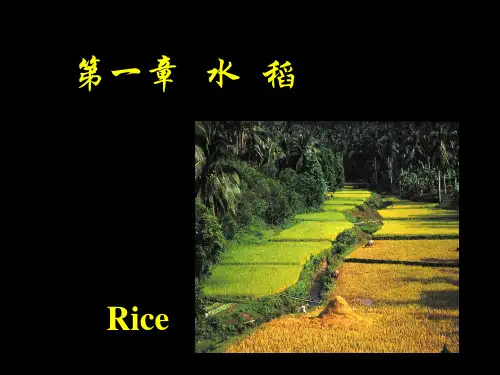
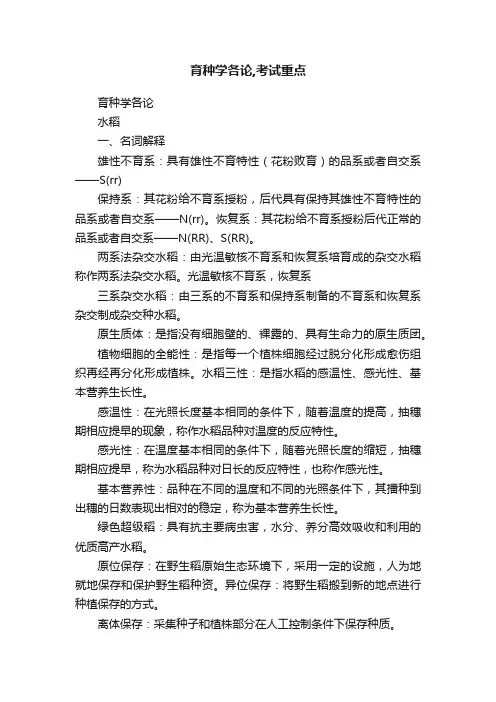
育种学各论,考试重点育种学各论水稻一、名词解释雄性不育系:具有雄性不育特性(花粉败育)的品系或者自交系——S(rr)保持系:其花粉给不育系授粉,后代具有保持其雄性不育特性的品系或者自交系——N(rr)。
恢复系:其花粉给不育系授粉后代正常的品系或者自交系——N(RR)、S(RR)。
两系法杂交水稻:由光温敏核不育系和恢复系培育成的杂交水稻称作两系法杂交水稻。
光温敏核不育系,恢复系三系杂交水稻:由三系的不育系和保持系制备的不育系和恢复系杂交制成杂交种水稻。
原生质体:是指没有细胞壁的、裸露的、具有生命力的原生质团。
植物细胞的全能性:是指每一个植株细胞经过脱分化形成愈伤组织再经再分化形成植株。
水稻三性:是指水稻的感温性、感光性、基本营养生长性。
感温性:在光照长度基本相同的条件下,随着温度的提高,抽穗期相应提早的现象,称作水稻品种对温度的反应特性。
感光性:在温度基本相同的条件下,随着光照长度的缩短,抽穗期相应提早,称为水稻品种对日长的反应特性,也称作感光性。
基本营养性:品种在不同的温度和不同的光照条件下,其播种到出穗的日数表现出相对的稳定,称为基本营养生长性。
绿色超级稻:具有抗主要病虫害,水分、养分高效吸收和利用的优质高产水稻。
原位保存:在野生稻原始生态环境下,采用一定的设施,人为地就地保存和保护野生稻种资。
异位保存:将野生稻搬到新的地点进行种植保存的方式。
离体保存:采集种子和植株部分在人工控制条件下保存种质。
垩白率:垩白粒占供试米粒数的百分比。
垩白大小:垩白投影面积占整个米粒投影面积的百分比。
垩白度:垩白率和垩白大小的乘积。
质核互作不育性:指的是雄性不育性由细胞核基因和细胞质基因共同控制的雄性不育类型。
光温敏核不育水稻:指由于受和基因的控制对温度和光照长度反应敏感,在长日照条件下表现出雄性不育特性的水稻植株。
水稻广亲和性:指一些中间型水稻材料,与籼稻和粳稻杂交,F1都能正常结实。
具有这种特性的品种,称为广亲和品种。
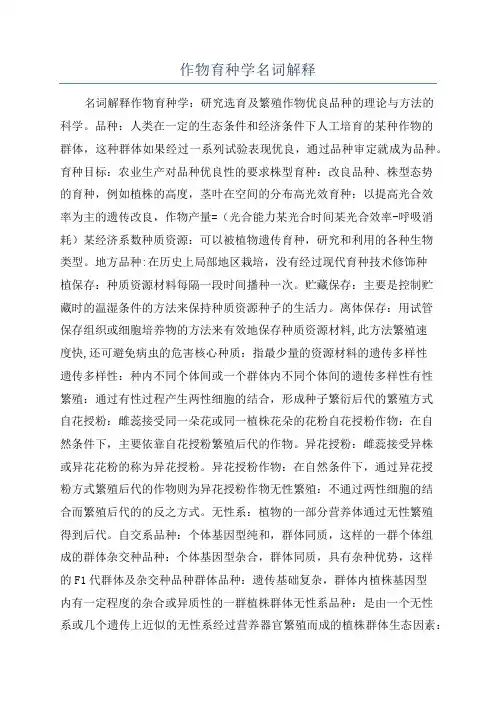
作物育种学名词解释名词解释作物育种学:研究选育及繁殖作物优良品种的理论与方法的科学。
品种:人类在一定的生态条件和经济条件下人工培育的某种作物的群体,这种群体如果经过一系列试验表现优良,通过品种审定就成为品种。
育种目标:农业生产对品种优良性的要求株型育种:改良品种、株型态势的育种,例如植株的高度,茎叶在空间的分布高光效育种:以提高光合效率为主的遗传改良,作物产量=(光合能力某光合时间某光合效率-呼吸消耗)某经济系数种质资源:可以被植物遗传育种,研究和利用的各种生物类型。
地方品种:在历史上局部地区栽培,没有经过现代育种技术修饰种植保存:种质资源材料每隔一段时间播种一次。
贮藏保存:主要是控制贮藏时的温湿条件的方法来保持种质资源种子的生活力。
离体保存:用试管保存组织或细胞培养物的方法来有效地保存种质资源材料,此方法繁殖速度快,还可避免病虫的危害核心种质:指最少量的资源材料的遗传多样性遗传多样性:种内不同个体间或一个群体内不同个体间的遗传多样性有性繁殖:通过有性过程产生两性细胞的结合,形成种子繁衍后代的繁殖方式自花授粉:雌蕊接受同一朵花或同一植株花朵的花粉自花授粉作物:在自然条件下,主要依靠自花授粉繁殖后代的作物。
异花授粉:雌蕊接受异株或异花花粉的称为异花授粉。
异花授粉作物:在自然条件下,通过异花授粉方式繁殖后代的作物则为异花授粉作物无性繁殖:不通过两性细胞的结合而繁殖后代的的反之方式。
无性系:植物的一部分营养体通过无性繁殖得到后代。
自交系品种:个体基因型纯和,群体同质,这样的一群个体组成的群体杂交种品种:个体基因型杂合,群体同质,具有杂种优势,这样的F1代群体及杂交种品种群体品种:遗传基础复杂,群体内植株基因型内有一定程度的杂合或异质性的一群植株群体无性系品种:是由一个无性系或几个遗传上近似的无性系经过营养器官繁殖而成的植株群体生态因素:指对作物生长发育有明显的影响或被植物直接吸收的因素,影响最大的是气候因素,如温度,日照,雨量生态环境:各种生态因素的综合体生态区:指对某种作物来说具有大致相似的环境地区生态型:指在一定的环境内莆成具有相似生态特性的品种类型称作物品种的生态型驯化:指人类为了让植物适应新的地理环境,而对其适应能力的利用和改造引种:①狭义:指从外国或外地引进作物新品种通过适应性试验直接在本地推广种植;②广义:从外地或外国引进新植物,新作物,新品种,品系以及供研究用的各种遗传资源材料选择:从群体中根据个体的表现型挑取符合育种目标的基因型(群体分为自然变异的群体和人工培育的群体,此指前者)品系:来自不同祖先,基因型相对一致,表现型相对整齐一致这样的个体所组成的群体鉴定:利用科学的方法对育种材料作出客观的评介选择育种:直接利用自然变异通过混合选择或单株选择的方法选育新品种系统育种:直接利用自然变异,通过单株选择的方法选育新品种称为系统育种剩余变异:指自交后代群体中残留的杂合基因所引起的变异杂交育种:通过不同品种间的杂交并且对后代进行选择的育种方法远缘杂交:种或种以上不同作物的杂交组合育种:利用基因的重组和互作,控制不同性状的优良基因,通过杂交重组后可以把不同亲本的优良性状结合在一起超亲育种:利用基因的累加和互作,控制同一性状的微小基因,通过基因重组后再通过累加和互作使产生的新性状超过任何同一亲本叫超亲育种杂交方式:在一个杂交组合中用几个亲本以及各个亲本的先后顺序叫杂交方式复交:3个或3个以上的亲本进行2次或2次以上的杂交叫复交单交:两个亲本进行杂交叫单交双交:三个或四个亲本,指两个单交的F1再杂交系统群:来自同一系统的不同单株所形成的系统叫系统群姊妹系:同一系统群内的不同系统之间互称姊妹系回交育种:通过回交,选择改良品种的方法。
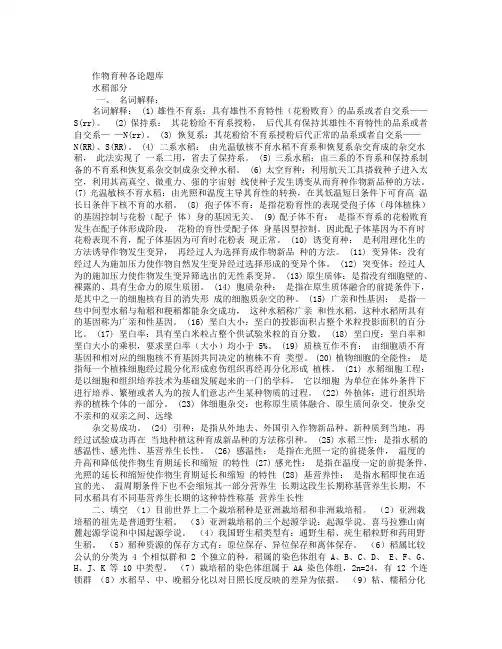
作物育种各论题库水稻部分一、名词解释:名词解释: (1) 雄性不育系:具有雄性不育特性(花粉败育)的品系或者自交系——S(rr)。
(2) 保持系:其花粉给不育系授粉,后代具有保持其雄性不育特性的品系或者自交系——N(rr)。
(3) 恢复系:其花粉给不育系授粉后代正常的品系或者自交系——N(RR)、S(RR)。
(4) 二系水稻:由光温敏核不育水稻不育系和恢复系杂交育成的杂交水稻,此法实现了一系二用,省去了保持系。
(5) 三系水稻:由三系的不育系和保持系制备的不育系和恢复系杂交制成杂交种水稻。
(6) 太空育种:利用航天工具搭载种子进入太空,利用其高真空、微重力、强的宇宙射线使种子发生诱变从而育种作物新品种的方法。
(7) 光温敏核不育水稻:由光照和温度主导其育性的转换,在其低温短日条件下可育高温长日条件下核不育的水稻。
(8) 孢子体不育:是指花粉育性的表现受孢子体(母体植株)的基因控制与花粉(配子体)身的基因无关。
(9) 配子体不育:是指不育系的花粉败育发生在配子体形成阶段,花粉的育性受配子体身基因型控制。
因此配子体基因为不育时花粉表现不育,配子体基因为可育时花粉表现正常。
(10) 诱变育种:是利用理化生的方法诱导作物发生变异,再经过人为选择育成作物新品种的方法。
(11) 变异体:没有经过人为施加压力使作物自然发生变异经过选择形成的变异个体。
(12) 突变体:经过人为的施加压力使作物发生变异筛选出的无性系变异。
(13) 原生质体:是指没有细胞壁的、裸露的、具有生命力的原生质团。
(14) 胞质杂种:是指在原生质体融合的前提条件下,是其中之一的细胞核有目的消失形成的细胞质杂交的种。
(15) 广亲和性基因:是指一些中间型水稻与籼稻和粳稻都能杂交成功,这种水稻称广亲和性水稻,这种水稻所具有的基因称为广亲和性基因。
(16) 垩白大小:垩白的投影面积占整个米粒投影面积的百分比。
(17) 垩白率:具有垩白米粒占整个供试验米粒的百分数。
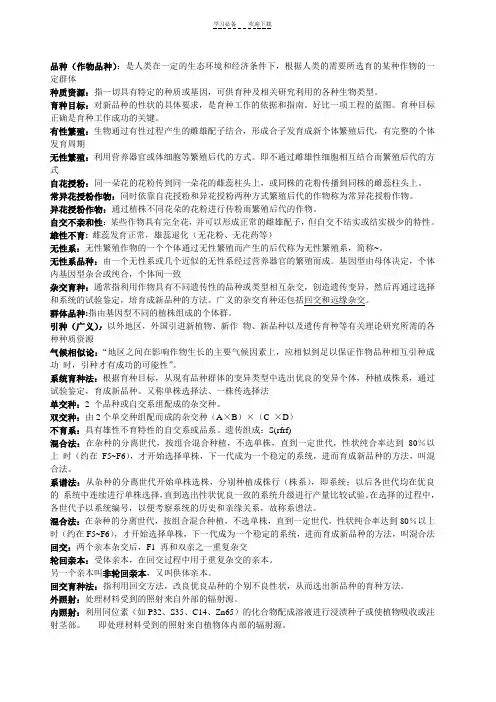
品种(作物品种):是人类在一定的生态环境和经济条件下,根据人类的需要所选育的某种作物的一定群体种质资源:指一切具有特定的种质或基因,可供育种及相关研究利用的各种生物类型。
育种目标:对新品种的性状的具体要求,是育种工作的依据和指南。
好比一项工程的蓝图。
育种目标正确是育种工作成功的关键。
有性繁殖:生物通过有性过程产生的雌雄配子结合,形成合子发育成新个体繁殖后代,有完整的个体发育周期无性繁殖:利用营养器官或体细胞等繁殖后代的方式。
即不通过雌雄性细胞相互结合而繁殖后代的方式自花授粉:同一朵花的花粉传到同一朵花的雌蕊柱头上,或同株的花粉传播到同株的雌蕊柱头上。
常异花授粉作物:同时依靠自花授粉和异花授粉两种方式繁殖后代的作物称为常异花授粉作物。
异花授粉作物:通过植株不同花朵的花粉进行传粉而繁殖后代的作物。
自交不亲和性:某些作物具有完全花,并可以形成正常的雌雄配子,但自交不结实或结实极少的特性。
雄性不育: 雌蕊发育正常,雄蕊退化(无花粉、无花药等)无性系:无性繁殖作物的一个个体通过无性繁殖而产生的后代称为无性繁殖系,简称~。
无性系品种:由一个无性系或几个近似的无性系经过营养器官的繁殖而成。
基因型由母体决定,个体内基因型杂合或纯合,个体间一致杂交育种:通常指利用作物具有不同遗传性的品种或类型相互杂交,创造遗传变异,然后再通过选择和系统的试验鉴定,培育成新品种的方法。
广义的杂交育种还包括回交和远缘杂交。
群体品种:指由基因型不同的植株组成的个体群。
引种(广义):以外地区,外国引进新植物、新作物、新品种以及遗传育种等有关理论研究所需的各种种质资源气候相似论:“地区之间在影响作物生长的主要气候因素上,应相似到足以保证作物品种相互引种成功时,引种才有成功的可能性”。
系统育种法:根据育种目标,从现有品种群体的变异类型中选出优良的变异个体,种植成株系,通过试验鉴定,育成新品种。
又称单株选择法、一株传选择法单交种:2 个品种或自交系组配成的杂交种。
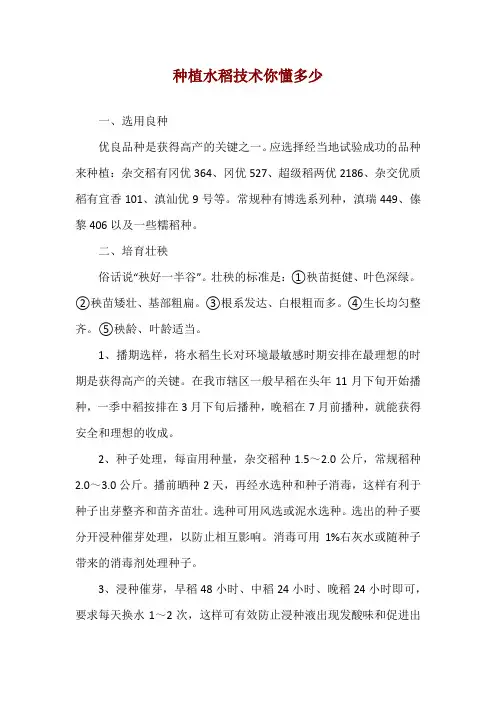
种植水稻技术你懂多少一、选用良种优良品种是获得高产的关键之一。
应选择经当地试验成功的品种来种植:杂交稻有冈优364、冈优527、超级稻两优2186、杂交优质稻有宜香101、滇汕优9号等。
常规种有博选系列种,滇瑞449、傣黎406以及一些糯稻种。
二、培育壮秧俗话说“秧好一半谷”。
壮秧的标准是:①秧苗挺健、叶色深绿。
②秧苗矮壮、基部粗扁。
③根系发达、白根粗而多。
④生长均匀整齐。
⑤秧龄、叶龄适当。
1、播期选样,将水稻生长对环境最敏感时期安排在最理想的时期是获得高产的关键。
在我市辖区一般早稻在头年11月下旬开始播种,一季中稻按排在3月下旬后播种,晚稻在7月前播种,就能获得安全和理想的收成。
2、种子处理,每亩用种量,杂交稻种1.5~2.0公斤,常规稻种2.0~3.0公斤。
播前晒种2天,再经水选种和种子消毒,这样有利于种子出芽整齐和苗齐苗壮。
选种可用风选或泥水选种。
选出的种子要分开浸种催芽处理,以防止相互影响。
消毒可用1%右灰水或随种子带来的消毒剂处理种子。
3、浸种催芽,早稻48小时、中稻24小时、晚稻24小时即可,要求每天换水1~2次,这样可有效防止浸种液出现发酸味和促进出芽整齐。
催芽应掌握“高温破胸(露白)、适温齐根芽”的原则。
早稻种不易升温可用温水(40°C~50°C)淋种,以促进种子迅速升温。
待根、芽长破壳出后就可播种,以种芽露白即播种为佳。
4、育秧方式有旱育秧、小拱棚膜育种(早稻)、常规水育秧、软盘育秧和塑盘育抛秧等。
旱育稀植是一项成功的技术,几年前已在大面积推广,但现在多数农户为图方便其将育秧方式已异化了,达不到应有的效果。
操作程序为,每亩大田用秧床10平方米(净面积),用农家20公斤,纯N、P、K各480克、255克和500克,翻耙入苗床中,浇透水后将厢面拍平,每平方米播干种100克或140克湿种,盖上过筛细土至不见种即可。
苗叶不卷叶不浇水,播后25天即可移栽。
目前可用国家农技推广总站建议推广的“旱育保姆”技术,将浸种后的湿谷或刚露芽谷进行拌种包衣后即可播种。
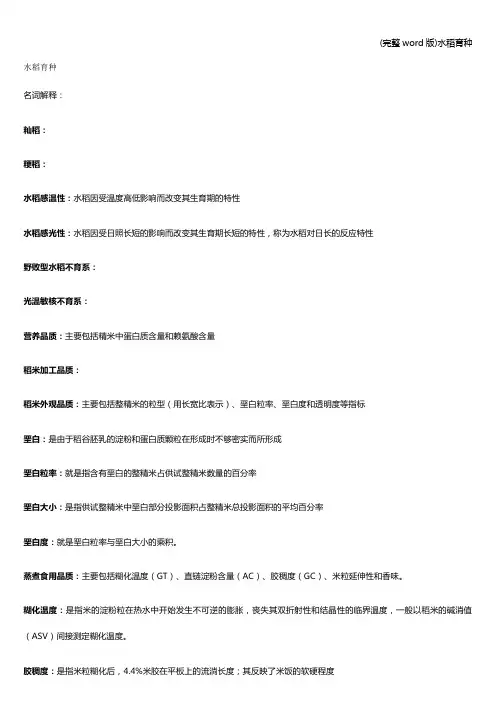
水稻育种名词解释:籼稻:粳稻:水稻感温性:水稻因受温度高低影响而改变其生育期的特性水稻感光性:水稻因受日照长短的影响而改变其生育期长短的特性,称为水稻对日长的反应特性野败型水稻不育系:光温敏核不育系:营养品质:主要包括精米中蛋白质含量和赖氨酸含量稻米加工品质:稻米外观品质:主要包括整精米的粒型(用长宽比表示)、垩白粒率、垩白度和透明度等指标垩白:是由于稻谷胚乳的淀粉和蛋白质颗粒在形成时不够密实而所形成垩白粒率:就是指含有垩白的整精米占供试整精米数量的百分率垩白大小:是指供试整精米中垩白部分投影面积占整精米总投影面积的平均百分率垩白度:就是垩白粒率与垩白大小的乘积。
蒸煮食用品质:主要包括糊化温度(GT)、直链淀粉含量(AC)、胶稠度(GC)、米粒延伸性和香味。
糊化温度:是指米的淀粉粒在热水中开始发生不可逆的膨胀,丧失其双折射性和结晶性的临界温度,一般以稻米的碱消值(ASV)间接测定糊化温度。
胶稠度:是指米粒糊化后,4.4%米胶在平板上的流淌长度;其反映了米饭的软硬程度绿色超级稻:水稻基本营养生长期:在最适于水稻生长发育的短日照、高温条件下,水稻品种也要经过一个必不可少的最低限度的营养生长期才能进入生殖生长、开始幼穗分化。
这个不受短日照、高温影响而缩短的营养生长期,称为“基本营养生长期”或“短日高温生长期”。
水稻广亲和性:中稻:杂交育种:是通过人工杂交将两个或两个以上亲本的优良性状综合到一个个体中,继而从分离的后代群体中,通过人工选择、培育和比较鉴定,获得遗传性相对稳定、有栽培利用价值的定型新品种的育种方法。
糯稻:秥稻:育种目标:是指在一定的自然、栽培和经济条件下,对计划选育的新品种提出应具备的优良特征特性,即对育成品种在生物学和经济学性状上的具体要求。
(高产、优质、稳产、生育期适宜、适于机械化操作)常规水稻:是指遗传特性稳定、当代和后代性状一致的品种,正常情况下可以留种,生产上不需要每年制种的水稻。
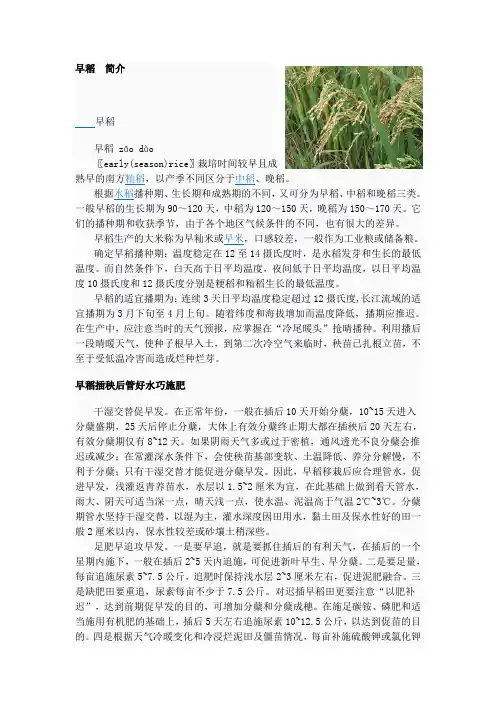
早稻简介早稻早稻zǎo dào〖early(season)rice〗栽培时间较早且成熟早的南方籼稻,以产季不同区分于中稻、晚稻。
根据水稻播种期、生长期和成熟期的不同,又可分为早稻、中稻和晚稻三类。
一般早稻的生长期为90~120天,中稻为120~150天,晚稻为150~170天。
它们的播种期和收获季节,由于各个地区气候条件的不同,也有很大的差异。
早稻生产的大米称为早籼米或早米,口感较差,一般作为工业粮或储备粮。
确定早稻播种期:温度稳定在12至14摄氏度时,是水稻发芽和生长的最低温度。
而自然条件下,白天高于日平均温度,夜间低于日平均温度,以日平均温度10摄氏度和12摄氏度分别是粳稻和籼稻生长的最低温度。
早稻的适宜播期为:连续3天日平均温度稳定超过12摄氏度,长江流域的适宜播期为3月下旬至4月上旬。
随着纬度和海拔增加而温度降低,播期应推迟。
在生产中,应注意当时的天气预报,应掌握在“冷尾暖头”抢晴播种。
利用播后一段晴暖天气,使种子根早入土,到第二次冷空气来临时,秧苗已扎根立苗,不至于受低温冷害而造成烂种烂芽。
早稻插秧后管好水巧施肥干湿交替促早发。
在正常年份,一般在插后10天开始分蘖,10~15天进入分蘖盛期,25天后停止分蘖,大体上有效分蘖终止期大都在插秧后20天左右,有效分蘖期仅有8~12天。
如果阴雨天气多或过于密植,通风透光不良分蘖会推迟或减少;在常灌深水条件下,会使秧苗基部变软、土温降低、养分分解慢,不利于分蘖;只有干湿交替才能促进分蘖早发。
因此,早稻移栽后应合理管水,促进早发,浅灌返青养苗水,水层以1.5~2厘米为宜,在此基础上做到看天管水,雨大、阴天可适当深一点,晴天浅一点,使水温、泥温高于气温2℃~3℃。
分蘖期管水坚持干湿交替,以湿为主,灌水深度因田用水,黏土田及保水性好的田一般2厘米以内,保水性较差或砂壤土稍深些。
足肥早追攻早发。
一是要早追,就是要抓住插后的有利天气,在插后的一个星期内施下,一般在插后2~5天内追施,可促进新叶早生、早分蘖。
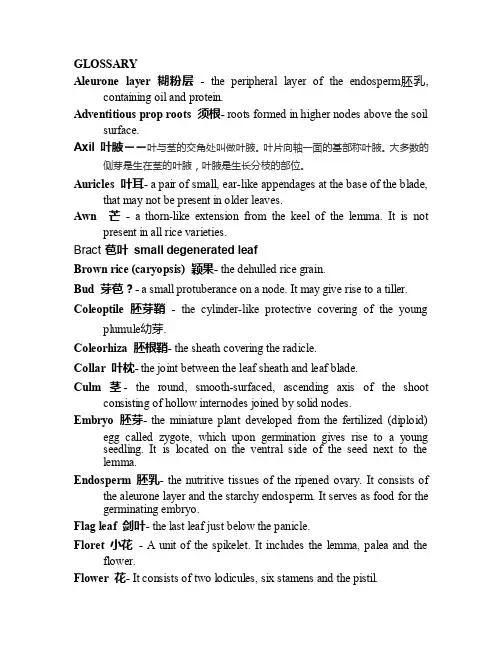
GLOSSARYAleurone layer 糊粉层- the peripheral layer of the endosperm胚乳, containing oil and protein.Adventitious prop roots 须根- roots formed in higher nodes above the soil surface.Axil 叶腋――叶与茎的交角处叫做叶腋。
叶片向轴一面的基部称叶腋。
大多数的侧芽是生在茎的叶腋,叶腋是生长分枝的部位。
Auricles 叶耳- a pair of small, ear-like appendages at the base of the blade, that may not be present in older leaves.Awn 芒- a thorn-like extension from the keel of the lemma. It is not present in all rice varieties.Bract苞叶small degenerated leafBrown rice (caryopsis) 颖果- the dehulled rice grain.Bud 芽苞?- a small protuberance on a node. It may give rise to a tiller. Coleoptile 胚芽鞘- the cylinder-like protective covering of the young plumule幼芽.Coleorhiza 胚根鞘- the sheath covering the radicle.Collar 叶枕- the joint between the leaf sheath and leaf blade.Culm 茎- the round, smooth-surfaced, ascending axis of the shoot consisting of hollow internodes joined by solid nodes.Embryo 胚芽- the miniature plant developed from the fertilized (diploid) egg called zygote, which upon germination gives rise to a youngseedling. It is located on the ventral side of the seed next to the lemma.Endosperm 胚乳- the nutritive tissues of the ripened ovary. It consists of the aleurone layer and the starchy endosperm. It serves as food for the germinating embryo.Flag leaf 剑叶- the last leaf just below the panicle.Floret 小花- A unit of the spikelet. It includes the lemma, palea and the flower.Flower 花- It consists of two lodicules, six stamens and the pistil.Grain - the ripened ovary and its associated structures.Hull 外壳- the lemma and palea, and their associated structures. Internode 节间- the smooth, solid (when young), or hollow (when mature) part of the culm between two successive nodes.Keel 外颖的中间叶脉(龙骨瓣?)- the middle nerve of the lemma. Leaf - the vegetative part of a tiller consisting of the blade and sheath.Leaf blade - the flat and free portion of the leaf.Leaf sheath 叶鞘- the lower part of the leaf, originating from a node and wrapped around the culm above the node.Lemma 外颖- the five-nerved bract of the floret.Ligule 叶舌- a thin, upright, membranous structure attached to the base of the inside of the flower.Lodicules 浆片- the two scale-like structures near the base of the palea. Mesocotyl 中胚轴- the internode between the coleoptile node and the point of union of the culm and root in the young seedlings. It pushes the coleoptile above the soil surface.Midrib 中脉- the prominent ridge in the middle of the underside of the leaf blade.Neck (panicle base) 颈?- the nearly solid node between the uppermost internode of the culm and the panicle axis. 在茎的最上节间与花序轴之间的节。
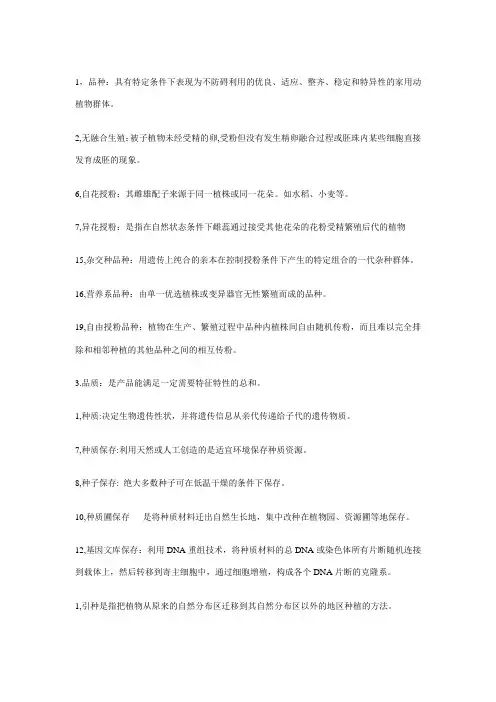
1,品种:具有特定条件下表现为不防碍利用的优良、适应、整齐、稳定和特异性的家用动植物群体。
2,无融合生殖:被子植物未经受精的卵,受粉但没有发生精卵融合过程或胚珠内某些细胞直接发育成胚的现象。
6,自花授粉:其雌雄配子来源于同一植株或同一花朵。
如水稻、小麦等。
7,异花授粉:是指在自然状态条件下雌蕊通过接受其他花朵的花粉受精繁殖后代的植物15,杂交种品种:用遗传上纯合的亲本在控制授粉条件下产生的特定组合的一代杂种群体。
16,营养系品种:由单一优选植株或变异器官无性繁殖而成的品种。
19,自由授粉品种:植物在生产、繁殖过程中品种内植株间自由随机传粉,而且难以完全排除和相邻种植的其他品种之间的相互传粉。
3.品质:是产品能满足一定需要特征特性的总和。
1,种质:决定生物遗传性状,并将遗传信息从亲代传递给子代的遗传物质。
7,种质保存:利用天然或人工创造的是适宜环境保存种质资源。
8,种子保存: 绝大多数种子可在低温干燥的条件下保存。
10,种质圃保存是将种质材料迁出自然生长地,集中改种在植物园、资源圃等地保存。
12,基因文库保存:利用DNA重组技术,将种质材料的总DNA或染色体所有片断随机连接到载体上,然后转移到寄主细胞中,通过细胞增殖,构成各个DNA片断的克隆系。
1,引种是指把植物从原来的自然分布区迁移到其自然分布区以外的地区种植的方法。
5,驯化引种:由于植物本身的适应性很窄,或引入地的生态条件与原产地的差异太大,植物在自然状况下生长不正常或死亡,但通过人为的干预措施对植物的遗传特性进行逐步改良,使原本不能生存的植物可以适应新的环境而正常生长。
2, 生态系统:在一定的时空范围内,生物和非生物成分通过物质循环、能量转化流动等相互作用、相互依存,所构成的具有一定结构和功能的一个生态复合体。
15,生态型是指同一种范围内在生物特征、形态特征与解剖结构上,与当地主要生态条件相适应的植物类型。
2,外来入侵种:那些在自然分布范围及扩散潜力以外,对生态系统环境,对人类健康、生产、生活带来危害的外来种、亚种等分类单元的生物物种。
作物育种学各论水稻育种试题库一、名词解释1、垩白质:是松散的淀粉,易碎,外观差2、糊化温度:即在米饭蒸煮时,稻米淀粉粒加热吸水膨胀至不可逆时的温度。
此时淀粉粒在偏光显微镜下失去双折射现象,所以也称双折射终点温度。
3、糙米率:稻谷去除果皮后的%4、精米率:糙米去除种皮、胚后的%5、整精米率:去除碎米后的整米%14、短日高温生育性15、雄性不育系16、雄性不育保持系17、雄性不育恢复系18、抱子体不育19、配子体不育20、光敏核不育性二、填空题1、水稻是世界上最重要的两大粮食作物之一,其栽培面积和总产仅次于小麦。
全世界种植水稻的国家和地区有112个之多,但栽培面积集中在亚洲,占世界水稻总栽培面积的90 %以上。
2、水稻是我国最重要的粮食作物,总面积、总产量及单位面积产量均居全国粮食作物首位。
3、我国是水稻原产地之一,亚洲栽培稻的祖先种普通野生稻分布极广:南起海南三亚,北至江西东乡,西起云南盈江,东至台湾桃园。
4、我国水稻分布跨越热带、亚热带、暖温带、中温带、寒温带等五个气候带,世界上种稻最北点在我国黑龙江省漠河,53° 27'。
5、我国水稻育种史上水稻矮化育种和杂交水稻两大事件被誉为水稻的绿色革命。
6、50年代标志着我国水稻矮化育种新纪元的3个里程碑式的矮杆品种是矮脚南特、广场矮、台中在来1号。
7、我国水稻区划分华南双季稻稻作区、华中双单季稻稻作区、西南高原单、双季稻稻作区、华北单季稻稻作区、东北早熟单季稻稻作区、西北干燥区单季稻稻作区等6个稻作区。
&江苏属于华中双单季稻稻作区,按照本省的水稻区划又可分太湖稻作区、镇宁扬丘陵稻作区、沿江稻作区、里下河稻作区、沿海稻作区、徐淮稻作区等6个稻作区。
9、根据江苏的地理位置和生态条件,适合本省种植的粳稻品种为 _________________ 、_______________ 、_________________ 、________________ 等4个熟期类型。
作物育种学:是研究选育及繁殖作物优良品种的理论与方法的科学。
品种:是人类在一定的生态条件和经济条件下,根据人类的需要所选育的某种作物的一定群体。
自然进化:由自然变异和自然选择演变发展的进化过程。
人工进化:是指由于人类发展生产的需要,人工创造变异并进行人工选择的进化,其中也包括有意识的利用自然变异和自然选择的作用。
自交系品种:又称纯系品种,是对突变或杂合基因型经过连续多代的自交加选择而得到的同质结合群体。
杂交种品种:它是在严格选择亲本和控制授粉的条件下生产的各类杂交组合的F1植株群体,其基因型是高度杂合的,群体又具有不同程度的同质性,表现出很高的生产力。
群体品种:其基本特点是遗传基础比较复杂,群体内植株的基因型有一定程度的杂合性或异质性。
无性系品种:是由一个无性系或几个遗传上近似的无性系经过营养器官繁殖而成的。
广义的种质资源:也称遗传资源、基因资源,一般是指具有特定种质或基因、可供育种及相关研究利用的各种生物类型。
狭义的种质资源:是指用于选育新品种的材料,也成为育种的原始材料。
育种目标:是指在一定的自然、栽培和经济条件下,对计划选育的新品种提出应具备的优良特征特性,也就是对育成品种在生物学和经济学性状上的具体要求。
引种:广义的引种泛指从外地或外国引进新植物、新作物、新品种、品系以及供研究用的各种遗传资源资料。
狭义的引种是作物育种途径之一,指从外地区或外国引进的品种(品系),经过在本地试种鉴定试验,从中选出适宜本地栽培的品种,直接应用于生产或利用它们的某些优良性状作为育种的原始材料,间接地加以利用。
气候相似论:原产地区与引进地区之前,影响作物生产的主要因素,应尽可能相似,以保证品种互相引种成功的可能性。
生态因素:对作物的生长发育有明显影响和直接为作物所同化的因素。
生态环境:生态因素有气候的、土壤的、生物的,这些起综合性作用的生态因素的复合体称为生态环境。
生态类型:一种作物对一定地区的生态环境具有相应的遗传适应性,具有相似遗传适应性的一个品种类群称为作物生态类型。
1)孢子体自交不亲和:雌雄二倍体细胞之间相互抑制作用,使是花粉管不能进入柱头,如十字花科的自交不亲和性2)测交:测验自交系配合力所进行的杂交。
3)测交种:测交所用的共同亲本4)测验种:测交所得的后代5)二环系:从自交系间杂种品种中选育出的自交系6)高光效育种:通过提高作物本身光合作用能力和降低呼吸消耗的生理指标而提高作物产量的育种方法7)核心种质:采用一定方法,选择部分种质,以最小的资源数量和遗传重复,最大程度的代表种质多样性8)核质杂种:不同种属间的细胞核、细胞质存在一定程度的分化,不同质核间存在着不同的互作效应,异核、质结合可产生一定的杂种优势,即核质杂种优势,通过回交置换法可获得核质杂种I9)基因资源:指含有不同种质的所有作物类型,它可以小到具有植物遗传全能性的器官,组织和细胞,以至于控制生物遗传性状的基因,大到植物个体甚至种内许多个体的总和10)经济产量:指作物有价值器官部分的产量,是生物产量的一部分。
11)理想株型:获得最高的光能利用率,并将光合产物最大限度地输送到籽粒中去,通过提高收获指数而提高籽粒产量的作物类型12)配子体自交不亲和:配子体不亲和花粉能正常发芽,并能进入柱头,但划分进入柱头组织或胚囊后遇到卵细胞产生的某些物质,表现出相互抑制而无法受精,如禾本科植物13)起源中心:遗传类型有很大的多样性、比较集中、具有地区特有的变种性状和近亲野生类型或栽培类型的地区14)生物产量:生物产量是指作物整个生育期间通过光合作用生产和积累的有机物的总量,通常是指地上部的总干物质重量15)收获指数:(经济系数):生物产量转化为经济产量的效率,即经济产量与生物产量的比值16)特殊配合力:(SCA)是指两个特定亲本所组配F1在某种数量性状上的表现。
17)遗传多样性:广义的遗传多样性是指地球上所有生物所携带的遗传信息的总和。
但一般所指的遗传多样性是指种内的遗传多样性,即种内个体之间或一个群体内不同个体的遗传变异总和18)异附加系:在某物种染色体组的基础上,增加一个、一对或两对其他物种的染色体,从而形成一个具有另一物种特性的新类型个体。
水稻育种应用知识点总结一、水稻遗传育种原理1.遗传基础水稻的遗传基础是指水稻植株遗传信息的载体,包括基因、染色体等。
通过了解水稻的遗传基础,可以为水稻的育种提供理论基础。
2.基因型和表型水稻的基因型是指水稻植株基因的组合形式,而表型是指水稻植株的外部形态和生理特征。
水稻的基因型决定了其表型,通过对水稻的基因型和表型进行研究,可以为水稻的育种选择提供指导。
3.遗传变异水稻的遗传变异是指在水稻种质资源中存在的不同遗传类型,在育种过程中可以利用遗传变异来选择适应性更强的水稻品种。
4.遗传性状水稻的遗传性状包括产量性状、品质性状、抗逆性状等,通过对水稻的遗传性状进行研究,可以选育出具有优良性状的水稻品种。
二、水稻育种方法1.杂交育种杂交育种是指利用水稻的自交不纯性进行育种。
通过选用具有不同遗传优势的亲本进行杂交,可以培育出优良的水稻品种。
2.自交育种自交育种是指利用水稻的自交纯合性进行育种。
通过对同源亲本进行自交,可以筛选出具有纯合性状的水稻品种。
3.重组育种重组育种是指利用水稻材料的重组能力进行育种。
通过引入外源基因或进行基因组重组,可以培育出具有新的遗传特点的水稻品种。
4.转基因育种转基因育种是指利用转基因技术进行水稻育种。
通过引入外源基因,可以培育出抗逆性强、产量高、品质好的转基因水稻品种。
三、水稻育种技术1.选择育种选择育种是指通过对水稻植株的选种进行育种。
通过选择产量高、品质好、抗病虫害、适应性强的植株进行选种,可以培育出优良的水稻品种。
2.杂交组合优势杂交组合优势是指杂交后所产生的优势性状。
利用水稻的杂交组合优势可以培育出具有更高产量、更好品质的水稻品种。
3.种质资源利用种质资源利用是指利用水稻的种质资源进行育种。
通过对水稻的种质资源进行挖掘和综合利用,可以培育出适应不同环境条件和生产需求的水稻品种。
4.分子标记辅助育种分子标记辅助育种是指利用分子标记技术辅助水稻育种。
通过对水稻的基因进行分子标记,可以提高育种的效率和准确性。
1作物品种:某一栽培作物适应于一定的自然生态和生产经济条件,具有相对稳定的遗传性和相对一致性,生物特性和形态特征与同一作物的其他类似群体相区别的生态类型。
2自交系品种:是对突变或杂合基因型经过连续多代的自交加选择而得到的同质纯合群体。
3杂种品种:是在严格选择亲本和控制授粉的条件下生产的各类杂交组合的F1植株群体。
4无性系品种:是由一个无性系或几个遗传上近似的无性系经过营养器官繁殖而成的。
5地方品种:一般是指在局部地区内栽培的品种,多未经过现代育种技术的遗传修饰,所以又成农家品种。
?野生近缘种:指现代作物的野生近缘种及与作物近缘的杂草,包括介于栽培类型和野生类型之间的过度类型。
?体细胞杂交:诱导两个不同亲本的原生质体互相融合形成异核体,异核体再生出细胞壁进而在有丝分裂的过程中发生核融合。
这一过程称为 ̄ ̄6作物的育种目标:是指在一定的自然、栽培和经济条件下,计划选育的新品种应具备的优良特征特性,也就是对育成品种在生物学和经济学性状上的具体要求。
7高光效育种:是指通过提高作物本身光合能力和降低呼吸消耗的生理指标而提高作物产量的育种方法。
8选择育种:是指对现有品种群体中出现的自然变异进行形状鉴定、选择并通过品系比较试验、区域试验和生产试验培育农作物新品种的育种途径。
9混合选择育种:是从原始品种群体中,按育种目标的统一要求,选择一批个体,混合脱粒,所得的种子下季与原始品种的种子成对种植,从而进行比较鉴定,如经混合选择的群体确比原品种优越,就可以取代原品种,作为改良品种加以繁殖和推广。
10杂交育种:不同品种间杂交获得杂种,继而在杂种货代进行选择以育成符合生产要求的新品种。
11远缘杂交:通常将植物分类学上不同种、属或亲缘关系更远的植物类型间所进行的杂交称为远缘杂交。
12异附加系:是在某物种染色体组的基础上,增加1个、1对或2对其他物种的染色体,从而形成1个具有另一物种特性的新类型个体。
13异置换系:是指某物种的一对或几对染色体被另一物种的一对或几对染色体所取代而成的新类型个体。
水稻词汇与术语The need for a general glossary of the terminology used in rice production and rice research has been evident in the production of earlier documents, such as the Dictionary of Commonly Used Terms in Crop Improvement With particular reference to Rice, by A.O. Abifarin of IITA, Nigeria, in 1984, and the Rice Production Glossary published by IRRI in 1990.The present Glossary, loaded in September 1996, includes most of the terms used in these books and many more. Major additions came from glossaries annexed to proceedings of rice conferences and workshops published in the past by IRRI and partners.It was first compiled by Janice Puckridge. Gene Hettel coordinated the review by IRRI scientists who made various additions and corrections. Jay Maclean did the final sorting and collation and prepared the Glossary for the Web page.Thanks to all those who contributed to the Glossary. It is a tedious rather than a glamorous task, but the efforts by the various scientists and editors should be much appreciated by all who use this Glossary.The definitions given herein pertain only to the agricultural usage of the terms, many of which have other or broader meanings not described. However, given this restriction, it would nevertheless be presumptuous to suggest that the Glossary is fully accurate or complete. We welcome and look forward to additions and corrections for future editions, which will make the Glossary even more helpful.Downloaded by Huang Hui from IRRI.- 2 -A Terms A line .The male sterile parent involving cytoplasmic or cytoplasmic genetic male sterility developed to produce hybrid seed. It is also known as a cytoplasmic male sterile line.abnormal growth . Growth that deviates from the normal type or form due to various environmental factors such as disease, pests, soil condition, humidity, temperature, etc.absolute plating efficiency .The number of individual cells that give rise to colonies relative to the number of cells plated; expressed in percentage.absorb . To take in by chemical or molecular action or use as nourishment in the physiological processes of the plant.absorption . The process by which a substance passes from one system into another, e.g., from the soil solution into a plant's root cell or from the leaf surface into the leaf cells.absorption, active .Movement of ions and water into the plant root as a result of metabolic processes by the root, frequently against an activity gradient.acaricide . A pesticide that kills mites and ticks.accession .1). An addition (of a variety or strain) to a national or other register of varieties obtained by field collection or exchange.2). A variety, strain, or population registered at a research center and worth conserving.accession list. A reference list of a collection of cultivars, germplasm, or breeding lines that are stored or maintained.accession number .The identification number assigned to an accession.acclimation/acclimatization . Adjustment or adaptation of an individual to a different climate or environment.achene . Small, dry fruit with one seed.achlorophyllous . Lacking chlorophyll.acid equivalent (a.e.).The portion of pesticide that is theoretically converted into acid.acid soil. A soil with a pH value of less than 7.0; for practical purposes, soils with pH below 6.6.acid sulfate soil . A soil with a pH value of less than 4.0 when air-dried; contains a high amount of sulfate and yellow jarosite mottles. Abnormal growth of plants in this soil is due to (i) toxicity fromaluminum, iron, and hydrogen sulfide; and (ii) phosphorus deficiency.acquired characters . Phenotypic (see phenotype) changes produced on a plant by the environment during the plant's development. Such characters (defined) are uninheritable.actinomycetes .1). Bacteria with branching filaments.2). A nontaxonomic term applied to a group of organisms withcharacteristics intermediate between the simple bacteria and the true fungi. active collection. A breeder's term for a collection of germplasm that is used often and is maintained live.active ingredient (a.i.). The potent portion of a compound (such as fertilizer, insecticide, fungicide or herbicide applied on the soil or plant) used as basis to estimate the chemical effect. Useful for comparing the strength or toxicity of chemicals.active vegetative stage . The growth stage of plants when there is rapid development of leaves, tillers, branches, or stems.acuminate .Gradually tapering to a sharp, prolonged point (e.g., rice leaves).acute rodenticide . A poison for rodents that acts swiftly and causes death shortly after ingestion. An example is zinc phosphide.adapt .To fit or adjust to a particular environment or a set of specific climatic conditions through a change in the plant's growth and development.adaptability . The ability to adapt to different environments by modifications in physiological responses.adaptation . The process of becoming suited to new or different environmental conditions or for particular functions.adaptiveness .Degree of being adapted to a certain environment or environments.adaptive research . Research conducted to validate, modify, orcalibrate a new technology to specific soil, climate, socioeconomic, or environmental characteristics of a given area.adaxial. Upper. The side toward the axis. Ventral.additive effects of genes . The effects produced by the sum of more than one pair of genes to improve desirable characters or suppress undesirable characters of a plant.additive genes . Genes that have no dominance and the effect of each gene can be added to the phenotype.ADP .Adenosine-5'-diphosphate, a complex sugar-phosphorus compound formed as a result of expenditure of energy and the loss of a phosphate group from the energy-rich ATP (adenosine triphosphate) compounds.adsorption.1). The taking up of molecules or ions at a surface, including exchangeable cations and anions on soil particles.2). The sticking of a liquid, or gaseous or dissolved substance to a solid, resulting in higher concentration of the substance.adult . The mature stage.adult (Entomology).The mature stage of an insect which occurs after the nymphal or pupal stages. Adult insects usually have wings and mature sexual organs.adult plant resistance . Resistance manifested mainly in maturing plants and less apparent in the seedling stage.advanced generation .A generation later than the fourth or fifth after crossing. In general, most of the major genes are fixed at the advanced generation.Downloaded by Huang Hui from IRRI.- 3 -adventitious prop roots .Roots formed at the higher nodes above the soil surface.adventitious roots . Roots developing from the part of a plant other than roots, which are formed from nodes of the plant. After 10-20 days of growth, all roots of the rice plant are adventitious roots.aerenchyma . The lysigenous intercellular spaces in the parenchyma layer forming a system of air passages which ramifies through the leaves, stems, and roots of a rice plant.aerate . To impregnate with a gas, usually air.aerial branching at nodes (Br). New shoots which develop at nodes high on the culm following the cutting of panicles.aerial roots . Roots that grow above the ground from the nodes.aerial tillers . Tillers that grow above the ground level.aerobic . Growing only in the presence of molecular oxygen. Having molecular oxygen as part of the environment.aerobic digestion . The partial biological decomposition of suspended organic matter in waste water or sewage under aerated conditions.aeroponics . A technique in growing plants wherein the plants derive their nutrients and water from a mist of air and aqueous solution that come in contact with the roots.aestivation . The inactive or dormant state of a larva during summer.AFLP . Amplification fragment length polymorphism. A variant DNA amplification product of different size produced by DAF, PCR, or RAPD technique.African rice . Refers only to the cultivated O. glaberrima .agar . Mucilage derived from a seaweed. It forms a gel with water. It is used to solidify culture media on which microorganisms are grown.aged rice . Rice that is kept at least 4 mo after harvest. Expands more on cooking and less sticky than cooked, freshly harvested rice.agrarian system . A historically constituted and durable mode of exploitation of the environment; a technical system adapted to the bioclimatic conditions of a given area and which complies with its social conditions and needs at that moment.agricultural lime . A soil amendment consisting principally of calcium carbonate but including magnesium carbonate and perhaps other materials. This is used to furnish calcium and magnesium as elements for the growth of plants and to neutralize soil acidity.agricultural production system . The whole structured set of plants, animals, and activities selected by a farmer for his production unit to achieve its goals. It is a global system that is finalized by farmer socioeconomic objectives and related management strategy.agriculture . The practice of cultivation, farming, tillage and horticulture; plant and animal production.agroclimatic .Relating to the relationship between crop adaptation and climate.agroecological zones . Geographical mapping units based on climaticconditions and land forms that determine relatively homogeneous crop growing environments.agroeconomics . The economics of agriculture.agronomic characters . Plant characters related to crop production usually observed during plant growth; e.g., height, maturity, tiller number, panicle size, yield and quality factors.agronomy . 1). Science of agriculture that deals with all aspects offield crop production and soil management. 2). An applied ecological science.ahurice . An early rice similar to "Aus"; grown in Assam, India.albic horizon . A soil horizon from which clay and iron oxide have been removed (USDA, 1975).albino . A plant that lacks chlorophyll and turns white; a deficiency in normal pigment.aleurone layer .1).The peripheral layer of endosperm of the grainbeneath the seed coat which envelops the endosperm and contains oil and protein.2). It is a layer of high-protein cells surrounding the storage cells of the endosperm. Its function is tosecrete hydrolytic enzymes for digesting food reserves in the endosperm.alien gene . A gene transferred to the cultivated species from another related or unrelated species.aliquot . A small part or portion of a given amount (such as 5 ml out of 100 ml solution).alkali soil . A soil containing sufficient exchangeable sodium toadversely affect crop production. Its sodium adsorption ratio is greater than 15 and pH is > 8.5.alkali spreading value .The degree of spreading of six grains of milled rice in 10 ml 1.7% KOH for 23 h at room temperature or 30℃ using a seven-point score (7=completely spread, and 1=no reaction). Gelatinization temperature of starch is estimated based on spreading value: low (6-7); intermediate (4-5); intermediate-high (3); and high (1-2).alkaline . Having a pH higher than 7.alkaline soil . A soil with a pH value higher than 7.0; CaCO3 in the upper horizon from a few percent to 95%.alkalinity . The quality, state, or degree of being alkaline.allele . One of several possible mutational forms of a gene at a given genetic locus. One diploid individual can have a maximum of two forms (alleles), but there may be several alternate alleles in the species.allelemorph . In Mendelian inheritance, a pair of alternative forms of a gene in which one may be dominant and the other recessive.alleles, multiple . A series of alleles (more than 2) that affect the development of a character.alleles, pseudo .Alleles that are functionally similar but structurally different.Downloaded by Huang Hui from IRRI.- 4 -allelism . The relationship between alleles in different parents. When the alleles of two parents belong to the same gene (locus), they are allelic; otherwise, non-allelic.allelism test (complementation test).A test for determining whether changes occurred in the same gene so that complementation between genes is possible.allelochemicals .Nonnutritional substances produced by a plant that affect the behavior, growth, health, or physiology of another plant or insect.allelopathy . The phenomenon of suppressing the growth of one plant species by another through the release of a toxic substance.allogamous .Capable of cross fertilization or having cross-fertilizing nature.allogamy . Cross fertilization; opposite of autogamy.allomone . An allelochemical that causes negative effects on the recipient organism.alloploid/allopolyploid . A polyploid containing genetically different sets of chromosomes from two or more species, e.g., O. minuta with BBCC genomes is an allopolyploid.allozyme . see isozyme.alluvial fan . A fan or cone-shaped mass of sand and gravel deposited by a stream where it emerges from a narrow valley and spreads on to a plain or wide valley.alluvial . Pertaining to alluvium; a clayey, silty, sandy, or gravely material deposited by a stream or other bodies of running water.alluvial soil .Soil that has been deposited by any form of running water.alluvium . Mineral material (sand, silt, and clay) deposited by rivers.alternate host . An individual or plant other than the main or preferred host upon which a parasite (or its spores, eggs, larvae, etc.) or a disease organism (pathogen) could live.aman rice . A term used in Bangladesh and east India for lowland rice grown in the wet season during June to November.ambient air . Air that reflects surrounding environmental conditions.amensalism . An interaction between two organisms in which one organism is suppressed by toxins produced by the second.American wild rice .Not a species of rice. It is a wild grass found in the USA with grains similar to those of rice. Its scientific name is Zizania aquatica .amino acid .A substance with both basic and acidic properties synthesized by plants and animals; considered the building blocks of proteins.ammonia volatilization . The escape of nitrogen from the soil or floodwater as ammonia gas; causes loss of urea and the ammonium form of nitrogen fertilizer from floodwater or saturated soil surfaces. amphidiploid . 1). Said of plants resulting from a cross between twodifferent species and having the total chromosome complement of the parent species.2). Name given to allopolyploids which are produced when different genomes are combined through interspecific hybridization.amplicon .DNA region defined by two opposing primer amplification sites.amylase .The enzyme responsible for catalyzing the breakdown of starch into sugars; may be active in one of two forms: a-amylase and b-amylase.amylopectin . 1). A component of starch that has a high molecularweight, long-branched chain structures, and does not tend to gel in aqueous solutions.2). A type of starch molecule composed of long-branched chains of glucose units (a polysaccharide).3). The major and branched fraction of starch, aglucose polymer with 5,000--19,000 glucose units and mean chain length of 18-22 glucose units. Thisfraction contributes directly to gel consistency and has a long linear chain fraction in high amylose starch.amylose .1). In cereal endosperm, it is the starch fraction of moleculesor residues made up of glucose units, straight short chains (see nonwaxy endosperm).2). The essentially linear fraction of starch, a polymer of glucose (dextrose) with up to 1,000 glucose units. It gives a blue complex with iodine and contributes directly to cooked rice hardness. It is measured colorimetrically by its blue complex with iodine in acetate buffer.amylose content .The value representing the starch fraction of milled rice, or the amount of starch in the grain that determines its eating and cooking quality. Low-amylose rice varieties are moist, sticky, and glossy after cooking. Rice with a high amylose content cooks dry and fluffy.anaerobic holding system . A closed storage unit for partial digestion of liquid organic wastes in the absence of oxygen.anaerobic . The absence of molecular oxygen.analysis of variance (ANOVA or ANOV).1) A statistical procedure that allows subdivision of the total variation among experimental units into known sources of variation and provides a measure for each source. 2) The statistical analysis that tests the significance of variable sources.anaphase . The stage of cell division (mitosis and meiosis) in which the chromosome halves move toward the opposite poles of the spindle.anastomosis . A union of a hypha or vessel with another resulting in exchange of their contents. Fusion of hyphal cells of fungi involving the cell wall or cytoplasm.anatomy . Study of the internal structure of living beings.anatropous . Descriptive of an ovule in which the body is bent backward along the funiculus and adnate to it.androgenesis . The development of a haploid individual from a pollen grain or microspore.Downloaded by Huang Hui from IRRI.- 5 -anesthetize . To immobilize.aneuploid . An individual with a chromosome number that is not an exact multiple of the haploid chromosome complement.angiosperm . Flowering plant. One of a group of plants whose seeds are enclosed in a mature ovary (fruit).anisomeric genes . Several genes that have one-directional and unequal effects. Their expressivity and heritability are intermediate between those of major genes and polygenes.annealing . Formation of fully or partially double-stranded DNA molecules from complimentary single-stranded molecules.annual . Yearly; used for plants which complete their life cycle (seed to seed production and death) in 1 year or less.antagonism . In plant nutrition, the interference of one element with the absorption or utilization of an essential nutrient by plants.antagonistic symbiosis . A symbiotic association which is destructive to one of the symbionts or partners involved in the association.anteapical . Just near the apex.antenna (insects). A movable segmented appendage occurring in pairs on the head of an insect.antennal base . A fixed area around the point of origin of the antenna.antenodal . Any area before or preceding a node in an insect's wing.anther . The saclike structure of the male part (stamen) of a flower in which the pollen is formed. Anthers normally have two lobes or cavities that dehisce at anthesis and allow the pollen to disperse.anther/microspore culture .In vitro culture of anthers or microspores which allows the production of homozygous diploid (doubled haploid) plants.anthesis . The action or period of opening of a flower; the period of pollination, specifically the time when the stigma is ready to receive the dispersed pollen and fertilization takes place.anthocyanin .Any of a class of soluble glycoside pigments that are responsible for most of the blue to red colors in leaves, flowers, and other plant parts.anthraquic . Pertaining to an aquic soil moisture regime induced by human action such as bunding and leveling of land, or irrigation.antibiosis The antagonistic association between two organisms producing detrimental effects on one of them. It could also mean an association between one organism and a metabolic product of another.antibiotic .A chemical substance produced by certain microorganisms that retards or inhibits the growth of other microorganisms. Substance that acts to destroy or inhibit the growth of a microbe (e.g., bacteria or fungi).antibody . A protein produced in a warm-blooded animal in reaction to an injected foreign antigen and capable of reacting to that antigen.antidote . A remedy to counteract the toxic effects of a pesticide (e.g., atropine sulfate for carbamate and phosphate poisoning). antigen . Foreign protein and occasionally complex lipids,carbohydrates, and some nucleic acids, which upon injection into a warm-blooded animal, induce the production of antibodies.antisense . Strand of DNA or RNA complementary to the sense strand of a gene. Sense and antisense strands anneal in vivo and cause inactivation of the gene's expression.antiserum .The blood serum of a warm-blooded animal that contains antibodies.antixenosis . A term proposed by Kogan and Ortman to replace nonpreference. It conveys the idea that the plant is avoided as a bad host. A property of the plant that makes it not attractive to some feeding or ovipositing insects.AP-PCR . Single primer amplification method developed by Welsh and McClelland. Usually large single primers of 20-30 nucleotides are annealed to target DNA then amplified by PCR under nonstringent conditions for two cycles. Then stringency (i.e., temperature) is increased. Products are separated by polyacrylamide gel electrophoresis and autoradiography.apiculate . Ending in a short-pointed tip.apiculus . A small extension of the lemma or palea.apomixis . An asexual method of reproduction in which the seed develops without the union of egg and sperm. The resulting embryos have the same genetic constitution as that of the seed parent.apospory . A form of apomixis in which the embryo develops from the somatic cells of the nucellus.appendage . Any external outgrowth of a plant that does not have any apparent essential function.application rate .The amount of fertilizer, insecticide, or herbicide applied per unit area or volume in experiments or commercial production.applied research .Research in which results can be used immediately by the farmer and can be applied to the peculiar problems of a country or a region.appressorium . The swollen tip of a hypha or germ tube that facilitates attachment and penetration of the host tissue by the fungus pathogen.aquatic plant. A plant that grows and develops in standing water and provides sufficient aeration to the parts under water.aquic . Pertaining to a soil moisture regime characterized by water saturation of the soil at all depths for a least a few weeks every year (USDA, 1975).aquorizem . Soil characterized by a distinct accumulation horizon of iron oxide and manganese oxide below the traffic pan, formed as result of wetland rice cultivation.areolate . Marked out into small spaces, reticulate.argillic horizon . A soil horizon enriched by clay that has moved downward (USDA, 1975).aridic .A soil moisture regime that limits plant growth during much of the growing season.Downloaded by Huang Hui from IRRI.- 6 -aril . An outer covering of the seed arising from the stalk of the ovule or below the hilum, the pulpy inner pod.armyworm . The larva of the family Noctuidae which often travels in large populations from field to field. The armyworm moths are ash to light brown, with mottled forewings that have irregular white or light gray spots near the extreme tip or with two pale semicircular spots in the middle. Adults migrate from the grassy areas or upland crops to ricefields and deposit their eggs. The larvae move in armies and may eat entire rice plants.aroma . A distinct smell or odor.artesian water . Groundwater confined under hydrostatic pressure.arthropods . Any member of phylum Arthropoda having segmented body, thick exoskeleton that is shed from time to time, a number of jointed appendages, i.e., legs, antennae, cerci, etc., and a nervous system with double ventral cord.artificial manure .Any form of nutrient source that is not of natural origin.artificial medium . A substance having an agar base with different chemicals or other constituents developed to replace the normal food or diet in rearing insects or pathogens.arthropod . Animals in the Arthropoda, a phylum consisting of animals with jointed limbs, e.g., the Insecta (insect) and Arachnida (mites and spiders).artificial diet . Food source, other than the natural host plant,consisting of amounts of various components which are mixed and provided to insects in the rearing program. The diet may be holidic (chemically pure), meridic (one or more chemically undefined materials such as wheat germ), or xenic (host plant materials plus supplemental nutrients).ascomycetes .A group of fungi producing their sexual spores within asci.ascospore . A sexually produced spore borne in an ascus.ascus . A saclike cell of a hypha in which meiosis occurs and which contains the ascospores, usually eight.asexual reproduction . Reproduction that does not involve fertilization or the fusion of sexually dissimilar gametes.ash, plant . The inorganic residue, principally oxides, which remains after the ignition of plant tissue.Asian rice . Oryza sativa L. The cultivated rice believed to have originated in Asia.assimilates . Building blocks of carbohydrates manufactured by the leaves of the rice plant.assimilation .1). The utilization of inorganic and organic substances incell synthesis.2). Uptake of CO 2 by a leaf or canopy during the day time or plant foods utilized in building up a protoplasm and cell walls of the plant.3). Computer modeling of the rice crop growth.asymmetrical . Parts not equal or symmetrically arranged.asynapsis .Failure of pairing of homologous chromosomes during meiosis.ATP . Adenosine triphosphate, a nucleotide consisting of adenine, ribose sugar, and three phosphate groups; the major source of usable chemical energy in metabolism. On hydrolysis, ATP loses onephosphate to become adenosine diphosphate (ADP), releasing usable energy.attack . 1). To cause growth retardation or an economic yield loss fromdisease, insect, bird or other pests.2). To try to solve a problem at its source.auchenorrhyncha . A suborder of Hemiptera in which the beakappears to rise from the inferior portion of the head and in which the tarsi have three tarsomeres.auricle .1). A pair of small ear-like appendages borne at the base of the leaf blade and usually arising at the sides where the ligule and the base of the collar are joined.2). An ear-shaped appendage, usually occurring at the junction of the leaf sheath and the blade that may not be present in older leaves.ausrice. A photoperiod-insensitive, rainfed, drought-prone, lowland, or upland rice, broadcast and transplanted during the early part of the wet season from March to September in Bangladesh and from April to August in east India.autoclave . An airtight chamber that can be filled with steam under pressure or surrounded by another chamber for the steam and that is used for sterilizing, cooking or other purposes requiring moist temperatures above 212 oF or 100 ℃ . Used for sterilization.autogamy . Fertilization arising from self-pollination.autoinfection . Infection of a host by a microorganism or virus produced within or upon the body of the same host individual.autopolyploid . A polyploid which possesses duplication of the same set of chromosomes, or more than two sets of chromosomes, coming from same species.autoradiogram . The photographic record of a chromatogram that contains radioactively labeled compounds. Prepared by exposing a sensitive photographic film to the radioactive radiation by placing it in contact with the chromatogram.autoradiography . A method used to detect radioactive substances by their property to darken film superimposed on the compounds. Can be used on whole organisms or molecules separated by molecular methods such as electrophoresis.autosomes . Chromosomes not associated with sex of the bearer.autotroph .A cell or organism that manufactures its own food from CO2 and other small inorganic compounds by the process of photosynthesis.auxins . A group of growth regulators or plant hormones (natural or synthetic) that may stimulate cell growth and induce cell elongation or division; often induce adventitious roots, root development, and other growth processes including seed germination.available nutrient . An element in the soil which can be readily absorbed and assimilated by growing plants.。